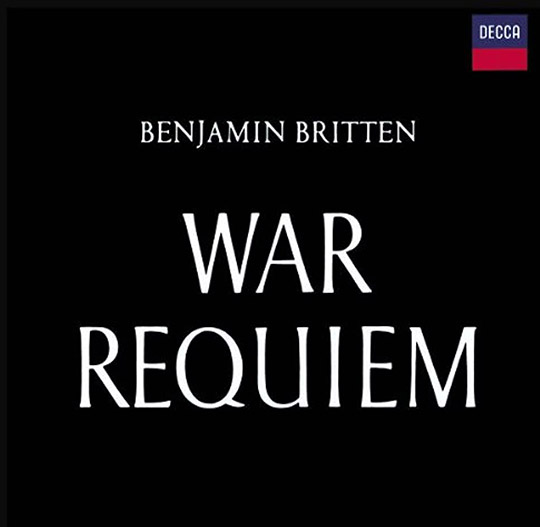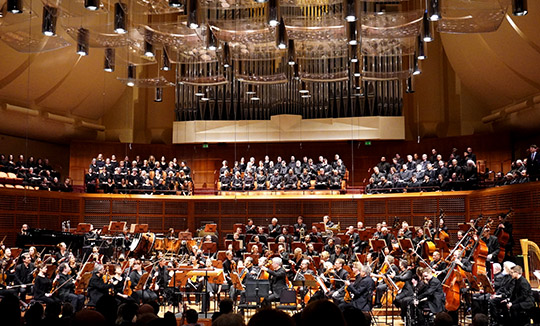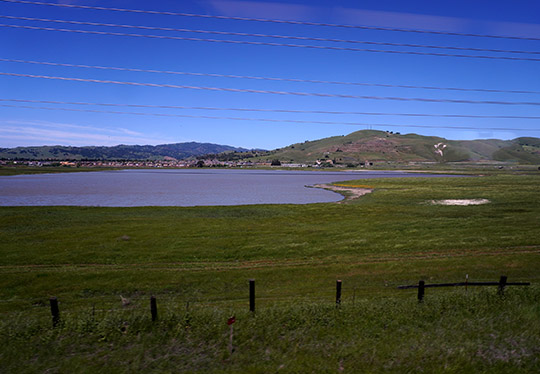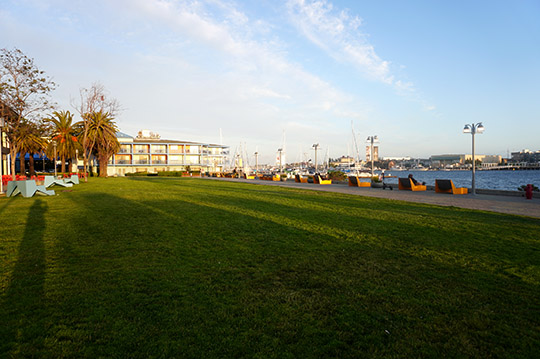Benjamin Britten's War Requiem premiered in 1962 and a recording with one of the most striking album covers in history was released in 1963. It featured the performers for whom it was written: English tenor Peter Pears, the German baritone Dietrich Fischer-Dieskau, and Russian soprano Galina Vishnevskaya, a trio from three countries that had just been at war with each other. To everyone's amazement, the 90-minute, two-disc set became a worldwide bestseller and may still be the best recording of the work, partly because Britten himself conducted his own score.
Last weekend the San Francisco Symphony along with the Symphony Chorus performed the work for the first time in a decade and as usual it was glorious to experience the work live.
It's a tricky piece to pull off in a live performance, though, because there are so many competing forces between soloists, chorus, full orchestra, chamber orchestra, and a large, distant boys chorus that is accompanied by an organ. The music bounces from ascetic to massive and everything in between, and it requires a conductor who can juggle and integrate all the moods. Unfortunately, Swiss conductor Philippe Jordan led most of the big choral sections as if they were Carl Orff's pounding Carmina Burana rather than Britten's brilliant riff on Verdi's Requiem. In the final Libera Me chorus, which should be taking the listener to a moment of shock and awe, there was instead just a huge wall of sound where voices and instruments were indistinguishable.
This was too bad because everyone else involved in the performance was so good. Though nobody is ever going to replace Vishnevskaya, who could somehow surf over huge waves of sound with full-throttled Slavic intensity, the young American soprano Jennifer Holloway held her own with a huge, beautiful voice.
The English tenor Ian Bostridge, who has been specializing in Britten for decades, was making his San Francisco Symphony debut. Though he often seemed to be singing in a different performance from everyone else with his hyper-enunciation and theatrical gestures, he felt true to the music and Wilfred Owens's WWI-era antiwar poetry. Brian Mulligan was a last-minute replacement and his gorgeous voice is a known quantity from his many appearances at the San Francisco Opera over the years in roles ranging from Sweeney Todd to Richard Nixon.
Bostridge and Mulligan were accompanied by a separate chamber orchestra seated on stage left, and their accompaniment was exquisite, one of the highlights of the evening.
The Ragazzi Boys Chorus sang from the top balcony, sounding like a distant chorus of angels.
The SF Symphony Chorus was also superb, but I have heard the ensemble sounding more soulful and subtle in this music. It would help to have a permanent replacement for Chorus Director, not to mention a more sympathetic conductor.
None of this mattered, though, because this pacifist masterwork managed to cast its spell again.
The "Let Us Sleep Now" duet between Ian Bostridge and Brian Mulligan which ends the requiem induced honest tears yet again, especially when joined for a final Latin prayer by Jennifer Holloway and both choruses.
Tuesday, May 23, 2023
Sunday, May 14, 2023
Víkingur Ólafsson's Mozart & Contemporaries Recital
Last Tuesday, San Francisco Performances presented the 39-year-old Icelandic pianist Víkingur Ólafsson in a live performance at Herbst Theater of his bestselling Deutsche Grammophon album from last year, Mozart & Contemporaries.
My friend James Parr is an Ólafsson groupie who recently became an enthusiast after obsessively listening to the pianist's Debussy Rameau album. Ólafsson's interests and repertory range all over the place, from J.S. Bach to Philip Glass, whose music he has also recorded.
Last June with the San Francisco Symphony, he gave a dynamite performance of John Adams's fiendishly difficult new piano concerto, Must The Devil Have All The Good Tunes?, and it was obvious he was a technical wizard but that doesn't necessarily mean somebody can play Mozart well.
It turned out that Ólafsson, in his first San Francisco recital, plays Mozart very well. However, the evening itself was strange and something of an endurance test for both performer and audience. When Ólafsson performed this program at Carnegie Hall in February, according to Zachary Woolfe's review in the NY Times, there was an intermission, but somewhere along the way in performances across the country, it vanished. The music was from the last decade of Mozart's life interspersed with contemporaneous piano pieces by Haydn, C.P.E. Bach, Cimarosa, and Galuppi. Even though there was a printed program, we were lost early and so was most of the audience, because Ólafsson's playing was so idiosyncratic in his pauses between the 14 pieces, sometimes barely a breath and other times a limb-stretching minute. This was also true for his rests between musical phrases and sonata movements, so when we finally did get back on track, it was with a keener level of concentration.
Still, listening to 90 straight minutes of piano music from the 1780s does put one in a sort of trancelike state, and I found myself more than once floating away dreamily into all kinds of interesting places. Even though this was a note-for-note reprise of his already streaming recording, the live performance was completely different, according to James, intensely personal and exploratory. It was a memorable night.
My friend James Parr is an Ólafsson groupie who recently became an enthusiast after obsessively listening to the pianist's Debussy Rameau album. Ólafsson's interests and repertory range all over the place, from J.S. Bach to Philip Glass, whose music he has also recorded.
Last June with the San Francisco Symphony, he gave a dynamite performance of John Adams's fiendishly difficult new piano concerto, Must The Devil Have All The Good Tunes?, and it was obvious he was a technical wizard but that doesn't necessarily mean somebody can play Mozart well.
It turned out that Ólafsson, in his first San Francisco recital, plays Mozart very well. However, the evening itself was strange and something of an endurance test for both performer and audience. When Ólafsson performed this program at Carnegie Hall in February, according to Zachary Woolfe's review in the NY Times, there was an intermission, but somewhere along the way in performances across the country, it vanished. The music was from the last decade of Mozart's life interspersed with contemporaneous piano pieces by Haydn, C.P.E. Bach, Cimarosa, and Galuppi. Even though there was a printed program, we were lost early and so was most of the audience, because Ólafsson's playing was so idiosyncratic in his pauses between the 14 pieces, sometimes barely a breath and other times a limb-stretching minute. This was also true for his rests between musical phrases and sonata movements, so when we finally did get back on track, it was with a keener level of concentration.
Still, listening to 90 straight minutes of piano music from the 1780s does put one in a sort of trancelike state, and I found myself more than once floating away dreamily into all kinds of interesting places. Even though this was a note-for-note reprise of his already streaming recording, the live performance was completely different, according to James, intensely personal and exploratory. It was a memorable night.
Wednesday, May 10, 2023
Pandora's Box at the Paramount
The San Francisco Film Festival presented the 1929 German silent film classic Pandora's Box at Oakland's Paramount Theater on Saturday, and it was an altogether splendid evening.
The Art Deco movie palace is looking beautifully restored and loved, and it seems a miracle the building was never torn down or disfigured.
The huge theater was almost filled...
...and of course many in the audience were in period costume because that's what you do in the Bay Area.
The two original "Lulu" plays by Frank Wedekind were written and took place in the 1890s, but director G.W. Pabst had updated the setting to 1920s Weimar Germany featuring one sleek Art Deco interior after another.
I recently read the two plays, Earth Spirit and Pandora's Box, for the first time, and my jaw kept dropping. Wedekind was deliberately trying to shock his fin de siècle audiences, and succeeded so well that he was imprisoned for obscenity by the government after Earth Spirit was published. The material is still shocking, beginning with the publishing tycoon Dr Schön who took Lulu off the streets into his family when she was 12 years old, and at an unspecified juncture made her his lover.
The film adaptation makes a few major changes but is actually more coherent than the original. Deleting the first two husbands from the play, who die onstage of a stroke and straight-razor suicide respectively, the movie begins with Dr Schön trying to get Lulu out of his life so he can marry a respectable woman. This does not work out well.
The movie has been censored, lost, and degraded over the decades, but the current digital restoration combining three different prints from around the world means that this is essentially a new movie, not seen the way it was meant to be for close to 100 years. The major set pieces, such as backstage at a colossal musical review, are astonishing, as is the cast, led by the 23-year-old American ingenue Louise Brooks who is perversely cheerful around all the mayhem that surrounds her.
Best of all, accompanying the film was the Club Foot Orchestra playing their own augmented 1995 score accompanied by six SF Conservatory musicians. With 15 total players, they sounded like a full symphony orchestra at times. The San Francisco Silent Film Festival is holding their annual five-day festival at the endangered Castro Theater in San Francisco July 12-16. Let us hope, pray and advocate for that civic treasure before it is irreparably ruined by its irresponsible owners, the Nasser family, and its proposed new managers, Another Planet Entertainment, which wants to turn it into a rock venue.
The Art Deco movie palace is looking beautifully restored and loved, and it seems a miracle the building was never torn down or disfigured.
The huge theater was almost filled...
...and of course many in the audience were in period costume because that's what you do in the Bay Area.
The two original "Lulu" plays by Frank Wedekind were written and took place in the 1890s, but director G.W. Pabst had updated the setting to 1920s Weimar Germany featuring one sleek Art Deco interior after another.
I recently read the two plays, Earth Spirit and Pandora's Box, for the first time, and my jaw kept dropping. Wedekind was deliberately trying to shock his fin de siècle audiences, and succeeded so well that he was imprisoned for obscenity by the government after Earth Spirit was published. The material is still shocking, beginning with the publishing tycoon Dr Schön who took Lulu off the streets into his family when she was 12 years old, and at an unspecified juncture made her his lover.
The film adaptation makes a few major changes but is actually more coherent than the original. Deleting the first two husbands from the play, who die onstage of a stroke and straight-razor suicide respectively, the movie begins with Dr Schön trying to get Lulu out of his life so he can marry a respectable woman. This does not work out well.
The movie has been censored, lost, and degraded over the decades, but the current digital restoration combining three different prints from around the world means that this is essentially a new movie, not seen the way it was meant to be for close to 100 years. The major set pieces, such as backstage at a colossal musical review, are astonishing, as is the cast, led by the 23-year-old American ingenue Louise Brooks who is perversely cheerful around all the mayhem that surrounds her.
Best of all, accompanying the film was the Club Foot Orchestra playing their own augmented 1995 score accompanied by six SF Conservatory musicians. With 15 total players, they sounded like a full symphony orchestra at times. The San Francisco Silent Film Festival is holding their annual five-day festival at the endangered Castro Theater in San Francisco July 12-16. Let us hope, pray and advocate for that civic treasure before it is irreparably ruined by its irresponsible owners, the Nasser family, and its proposed new managers, Another Planet Entertainment, which wants to turn it into a rock venue.
Sunday, May 07, 2023
Amtrak to Sacramento
I took Amtrak to Sacramento last Sunday to see the green hills from our abundantly wet winter before they turn brown.
I was also hoping to see evidence of The Big Melt from the Sierra snowpack...
...but reports of the predicted natural disaster were premature.
There were a few Warriors fans on their way to the 7th NBA playoff game between the Golden State Warriors and the Sacramento Kings.
However, most Bay Area fans taking Amtrak to Sacramento were on an earlier train that hit a "trespasser" in Hayward, and they were delayed for over two hours, missing much of the game's first half.
The ride home was lovely as we waited for new passengers in Davis, where a serial stabber was beginning a murder spree...
...unbeknownst to any of the passengers.
The reliably unreliable Amtrak was running perfectly on time the whole afternoon... ...but when we arrived in Emeryville the feeder bus to San Francisco was not there and nobody in the station seemed to know anything about its whereabouts.
After about 20 minutes, the San Joaquin train from Bakersfield to Oakland stopped to let off passengers while an announcement was made that this was a "drop-off" situation only...
...but I jumped on anyway with the amused approval of a conductor...
...and went to the ferry terminal at Jack London Square.
The sunset boat ride was an exquisite end to a day of public transportation...
...as we maneuvered past huge container ships on the way to San Francisco.
I was also hoping to see evidence of The Big Melt from the Sierra snowpack...
...but reports of the predicted natural disaster were premature.
There were a few Warriors fans on their way to the 7th NBA playoff game between the Golden State Warriors and the Sacramento Kings.
However, most Bay Area fans taking Amtrak to Sacramento were on an earlier train that hit a "trespasser" in Hayward, and they were delayed for over two hours, missing much of the game's first half.
The ride home was lovely as we waited for new passengers in Davis, where a serial stabber was beginning a murder spree...
...unbeknownst to any of the passengers.
The reliably unreliable Amtrak was running perfectly on time the whole afternoon... ...but when we arrived in Emeryville the feeder bus to San Francisco was not there and nobody in the station seemed to know anything about its whereabouts.
After about 20 minutes, the San Joaquin train from Bakersfield to Oakland stopped to let off passengers while an announcement was made that this was a "drop-off" situation only...
...but I jumped on anyway with the amused approval of a conductor...
...and went to the ferry terminal at Jack London Square.
The sunset boat ride was an exquisite end to a day of public transportation...
...as we maneuvered past huge container ships on the way to San Francisco.
Subscribe to:
Posts (Atom)








































